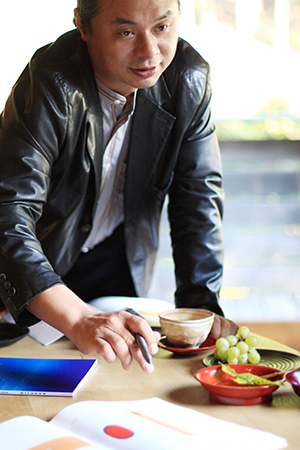 All of his spaces are sublime exercises into the possibilities of light, shadow, and form, all executed with a quiet simplicity and sophistication. While his designs are elegant, using traditional Japanese sensibilities, there is also a subdued tension in his spaces–a feeling that we are experiencing something cutting-edge and vanguard as opposed to staid and old.
All of his spaces are sublime exercises into the possibilities of light, shadow, and form, all executed with a quiet simplicity and sophistication. While his designs are elegant, using traditional Japanese sensibilities, there is also a subdued tension in his spaces–a feeling that we are experiencing something cutting-edge and vanguard as opposed to staid and old.
Interviewing the 46 year-old designer at his Yoyogi studio, he has a warm energy that is somewhat reflective of the humanism in his works. At the heart of his interior design is the ethos of coexistence with nature, and a respect of the base materials used.
“I try and go closer to the beauty and serenity that is inherent in nature, that feeling that is nature. For example, I have designed some restaurants. But they say that when you have a meal, the most comfortable place is outside. Like a garden party–bring a table, cloth and chairs and drink some sake and have a good time. Feeling the fabulous outside light and air, the food seems the most delicious. Therefore, when I make interior design, I can’t make it exactly like that, but I like to replicate that nice feeling of being outside.”
This is perhaps reflective of the differences in Japanese architecture on the whole, where instead of creating a dichotomy between the exterior and interior, man and nature, there is a fusion that is evident in traditional house designs where gardens are framed by shoji screens and bamboo lattices, and verandas encase the house.
Of his influences, Hashimoto says, “Rather than architects or designers, things that have been around for a long time, for example Katsura Rikyu [a villa belonging to the imperial royal family in Kyoto] or Ise shrine. And Taian.”
In fact, it was his encounter with Taian, a modest Kyoto tea ceremony room built by tea master Sen no Rikyu–who applied Zen practices and aesthetics to the art of tea–that shaped his career.
“When I was a student I was always thinking that I wanted to become a designer, however , in the beginning I was thinking fashion and apparel design would be interesting. When I was in university, I went to the Taian teahouse. It’s a small tea ceremony room with only two tatami mats. It’s very impressive, I was really moved, and I thought it would be great to be able to design these kinds of spaces. That was the impetus for me starting design.”
Taian, with its implicit wabi sabi beauty has many of the qualities that are evident in Hashimoto’s works now. The teahouse is the smallest of its kind in Japan, but with the use of three small windows that alter the quality of the light and the bamboo shadows on the shoji give this room a feeling of restrained serenity, but a sense of edginess.
Paramount in Hashimoto’s designs is neo traditionalism–a use of the crafts and arts of Japan, with their timely charm that has been handed down over generations. However Hashimoto renders their use in a contemporary, even theatrically futuristic manner to create an ambience that is unique–gentle and reassuring, warm yet cutting edge and cool.
In his interior works one can see the influences of aspects of Japanese culture such as mosquito nets, Kyoto’s alleyways, birds, burning charcoal, Zen gardens and summer parasols. However, these are usually teamed with cyber-esque LED lights, fiber optic tubes, and hanging lanterns, as well as collaborations with art luminaries such as photographer Araki Nobuyoshi.
These are the contrasts that characterize his works. Organic, yet artificial, chic, yet classic, vivacious and radical, yet homely and comfortable. Hashimoto explores the idea of “Using traditional materials, creating something that hasn’t been seen before.”
His Dancing on the Water clock design is a prime example. “I was thinking of using urushi in the context of our times. Not only as traditional art and an old thing, but I wanted to appeal to our contemporary lifestyle.
“Lately, those kinds of things aren’t used so often in our everyday life. Previously, we used to use urushi bowls to eat rice or for soup, but lately its quite rare, despite there being such a superior option. So we had to think of how to make the urushi something one would see everyday. We thought it would be interesting to make an urushi clock.
“You can read the time because it has the digital read out of the digits on the urushi face. So by creating a fusion of urushi and a clock that is essential for daily life, you can feel the original beauty of urushi everyday. Thus continuing tradition, and thinking of the future.”
 In a world that is characterized by excess, people often seek a place where they can feel at peace and comfortable. Each restaurant he has designed is almost a cathartic space. Instantaneously the visitor is engulfed in ambient space—an entirely immersive world.“Interiors are basically spaces and people come and experience them. Therefore it’s a place where all five senses can be used. Interior space appeals to all the senses… there is the lighting being used at a certain time, what kind of music is flowing. For example, if it were a restaurant, the food being served would also add to the feeling, and in this way interior design appeals to all the senses.
In a world that is characterized by excess, people often seek a place where they can feel at peace and comfortable. Each restaurant he has designed is almost a cathartic space. Instantaneously the visitor is engulfed in ambient space—an entirely immersive world.“Interiors are basically spaces and people come and experience them. Therefore it’s a place where all five senses can be used. Interior space appeals to all the senses… there is the lighting being used at a certain time, what kind of music is flowing. For example, if it were a restaurant, the food being served would also add to the feeling, and in this way interior design appeals to all the senses.
“I think that using light in space is an incredibly important element. If the light isn’t good, the space doesn’t look good either. So whenever I design, I think of light and space simultaneously as equally important elements. Each time I try various experimental ideas as well.”
Hashimoto has many works overseas, such as New York’s Chanto restaurant, Noble House in Taiwan and Lei Garden in Hong Kong. Each restaurant incorporates the respective countries’ unique style within the location’s design. Regarding his demand abroad, Hashimoto says modestly, “I don’t know how popular I am overseas exactly, but I think maybe it is because Japanese design is meticulous. Americans are really dynamic, and Europeans are quite decorative. Of course they have simple and modern designs too, but in Japan, the Zen style that was popular a bit before is incredibly simple and sensitive. Elements such as that, for example, may be what an overseas person can sense is missing in the designs from their own country.”
Typical to Zen sensibilities, instead of making things more brash and opulent, Hashimoto creates a sense of subdued simplicity created by minimalism, and an emphasis on quality materials such as wood, and stone.
For Hashimoto, whose designs can take up to two and a half years for something like his recent Peninsula Hotel project in Tokyo and up to three years for a residential house, he says his biggest challenge is actualizing his imagination.
“If it’s just the design, you can scribble it on paper as much as you like. But I think the most difficult thing to do is to render that design into something complete.” Surprisingly, Hashimoto confesses that product design is actually more difficult than doing interiors, admitting that sometimes it can take the same amount of time to create a small lamp as it takes to construct an expansive space. “A product,” Hashimoto explains, “is distributed by various people, and you don’t know how it will be used, so the thing in and of itself has to be incredibly fascinating.”
Splitting his time between interior design, which takes up eighty percent of his time, product design, teaching at Aichi Prefectural University of Fine Arts and Music several times a year, and at the Women’s College of Fine arts, he says he sometimes derives stimulation from students as well, saying, “The ideas born from people with no experience is quite interesting. Their ideas are sometimes adventurous and bold.”
 While his ongoing current project is an onsen ryokan, Hashimoto has other, more socially oriented, plans up his sleeve. “Up until now, I did quite a few commercial properties, but I would like to do more public jobs. For example, train stations, parks, and spaces that people use everyday. If I do those kinds of designs, people’s lifestyles will become more rich.”
While his ongoing current project is an onsen ryokan, Hashimoto has other, more socially oriented, plans up his sleeve. “Up until now, I did quite a few commercial properties, but I would like to do more public jobs. For example, train stations, parks, and spaces that people use everyday. If I do those kinds of designs, people’s lifestyles will become more rich.”
Having won numerous prizes such as the Takashimaya Art Award, the Japan creative Design 2e prix, the Japan Creative Design Shorei-sho and the Nashop Lighting Award Hashimoto is enjoying a life of success. However, the central lesson he has learned from his years of imagination, creation and achievement, is the necessity of belief and determination.
Asked to share some pearls of wisdom to young up and coming artists, he suggests, “The most important thing is to not give up. Whatever it is, there is always a road. When one has an idea, and when you make it into a reality there are always hazards and obstacles that make it seem impossible, but you will always find a way. So if you have faith, there is always a way to make it into a reality.”
Hashimoto’s reality can be seen in shops, bars, cafes, residential buildings, and over 150 restaurants all over Japan, and internationally. While each project is entirely different from the next, all are sublime manifestations of this visionaries’ creative mind. If you get the chance, visit one of his spaces and discover the potential of light, and shadows, coupled with a contemporary outlook that has a quiet respect for the venerable traditions of Japan.
Story by Manami Okazaki
From J SELECT Magazine, April 2008















Recent Comments